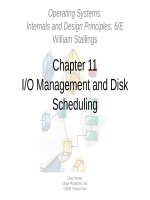Lecture Operating systems Internals and design principles (6 E) Chapter 11 William Stallings
Bạn đang xem bản rút gọn của tài liệu. Xem và tải ngay bản đầy đủ của tài liệu tại đây (594.1 KB, 90 trang )
Operating Systems:
Internals and Design Principles, 6/E
William Stallings
Chapter 11
I/O Management and Disk Scheduling
Dave Bremer
Otago Polytechnic, NZ
©2008, Prentice Hall
Roadmap
– I/O Devices
– Organization of the I/O Function
– Operating System Design Issues
– I/O Buffering
– Disk Scheduling
– Raid
– Disk Cache
– UNIX SVR4 I/O
– LINUX I/O
– Windows I/O
Categories of
I/O Devices
•
Difficult area of OS design
– Difficult to develop a consistent solution due to a wide variety of devices and
applications
•
Three Categories:
– Human readable
– Machine readable
– Communications
Human readable
•
•
Devices used to communicate with the user
Printers and terminals
– Video display
– Keyboard
– Mouse etc
Machine readable
•
Used to communicate with electronic equipment
– Disk drives
– USB keys
– Sensors
– Controllers
– Actuators
Communication
•
Used to communicate with remote devices
– Digital line drivers
– Modems
Differences in
I/O Devices
•
Devices differ in a number of areas
– Data Rate
– Application
– Complexity of Control
– Unit of Transfer
– Data Representation
– Error Conditions
Data Rate
•
May be massive
difference between the
data transfer rates of
devices
Application
– Disk used to store files requires file management software
– Disk used to store virtual memory pages needs special hardware and software
to support it
– Terminal used by system administrator may have a higher priority
Complexity of control
•
•
•
A printer requires a relatively simple control interface.
A disk is much more complex.
This complexity is filtered to some extent by the complexity of the I/O
module that controls the device.
Unit of transfer
•
Data may be transferred as
– a stream of bytes or characters (e.g., terminal I/O)
– or in larger blocks (e.g., disk I/O).
Data representation
•
Different data encoding schemes are used by different devices,
– including differences in character code and parity conventions.
Error Conditions
•
•
The nature of errors differ widely from one device to another.
Aspects include:
– the way in which they are reported,
– their consequences,
– the available range of responses
Roadmap
– I/O Devices
– Organization of the I/O Function
– Operating System Design Issues
– I/O Buffering
– Disk Scheduling
– Raid
– Disk Cache
– UNIX SVR4 I/O
– LINUX I/O
– Windows I/O
Techniques for
performing I/O
•
•
•
Programmed I/O
Interrupt-driven I/O
Direct memory access (DMA)
Evolution of the
I/O Function
1.
2.
Processor directly controls a peripheral device
Controller or I/O module is added
– Processor uses programmed I/O without interrupts
– Processor does not need to handle details of external devices
Evolution of the
I/O Function cont…
3.
Controller or I/O module with interrupts
– Efficiency improves as processor does not spend time waiting for an I/O
operation to be performed
4.
Direct Memory Access
– Blocks of data are moved into memory without involving the processor
– Processor involved at beginning and end only
Evolution of the
I/O Function cont…
5.
I/O module is a separate processor
–
6.
CPU directs the I/O processor to execute an I/O program in main memory.
I/O processor
– I/O module has its own local memory
– Commonly used to control communications with interactive terminals
Direct Memory Address
•
Processor delegates I/O operation to the DMA
module
•
DMA module transfers data directly to or form
memory
•
When complete DMA module sends an
interrupt signal to the processor
DMA Configurations:
Single Bus
•
•
DMA can be configured in several ways
Shown here, all modules share the same system bus
DMA Configurations:
Integrated DMA & I/O
•
•
Direct Path between DMA and I/O modules
This substantially cuts the required bus cycles
DMA Configurations:
I/O Bus
•
Reduces the number of I/O interfaces in the DMA module
Roadmap
– I/O Devices
– Organization of the I/O Function
– Operating System Design Issues
– I/O Buffering
– Disk Scheduling
– Raid
– Disk Cache
– UNIX SVR4 I/O
– LINUX I/O
– Windows I/O
Goals: Efficiency
•
•
Most I/O devices extremely slow compared to main memory
Use of multiprogramming allows for some processes to be waiting on I/O
while another process executes
•
I/O cannot keep up with processor speed
– Swapping used to bring in ready processes
– But this is an I/O operation itself
Generality
•
For simplicity and freedom from error it is desirable to handle all I/O
devices in a uniform manner
•
•
Hide most of the details of device I/O in lower-level routines
Difficult to completely generalize, but can use a hierarchical modular
design of I/O functions









